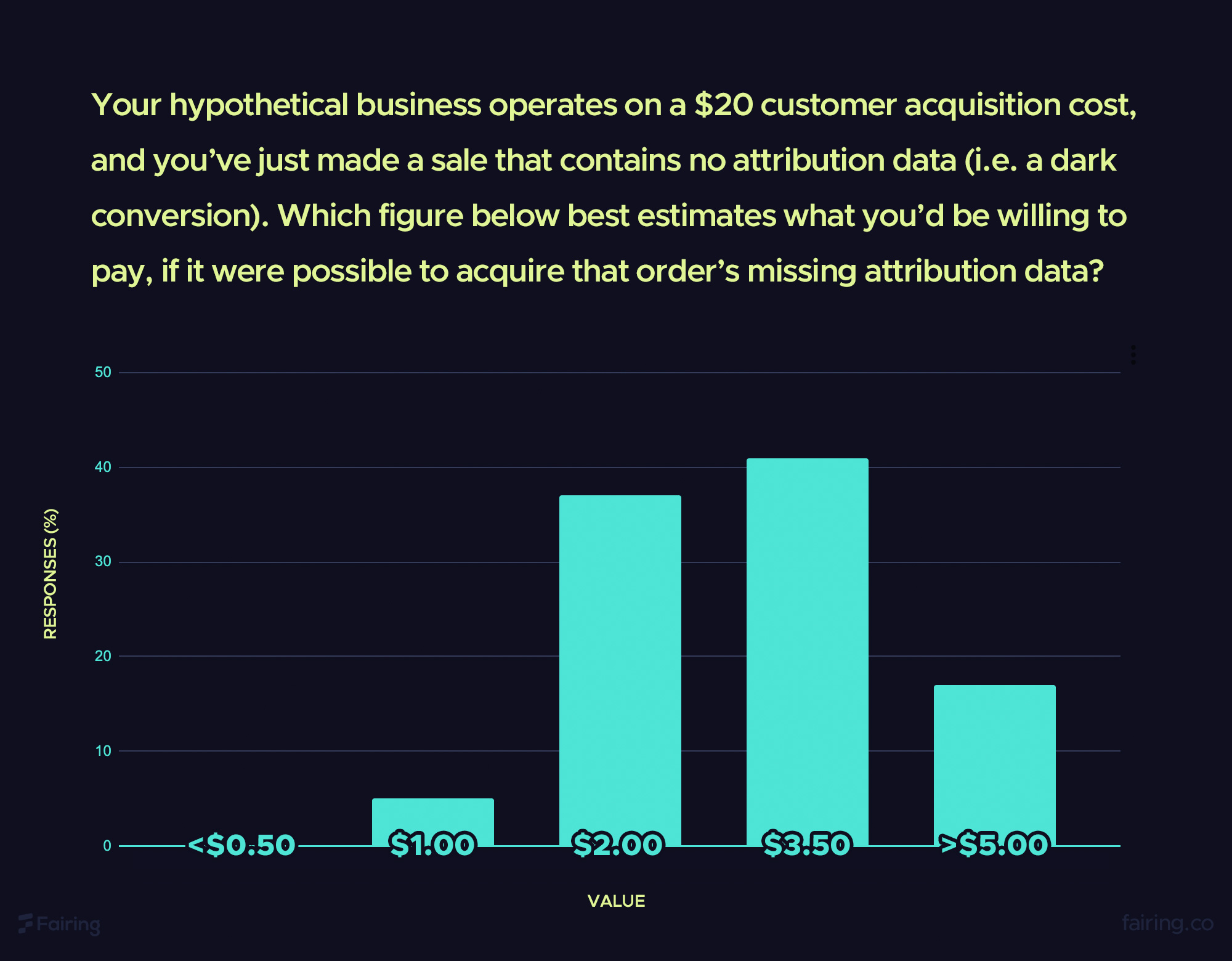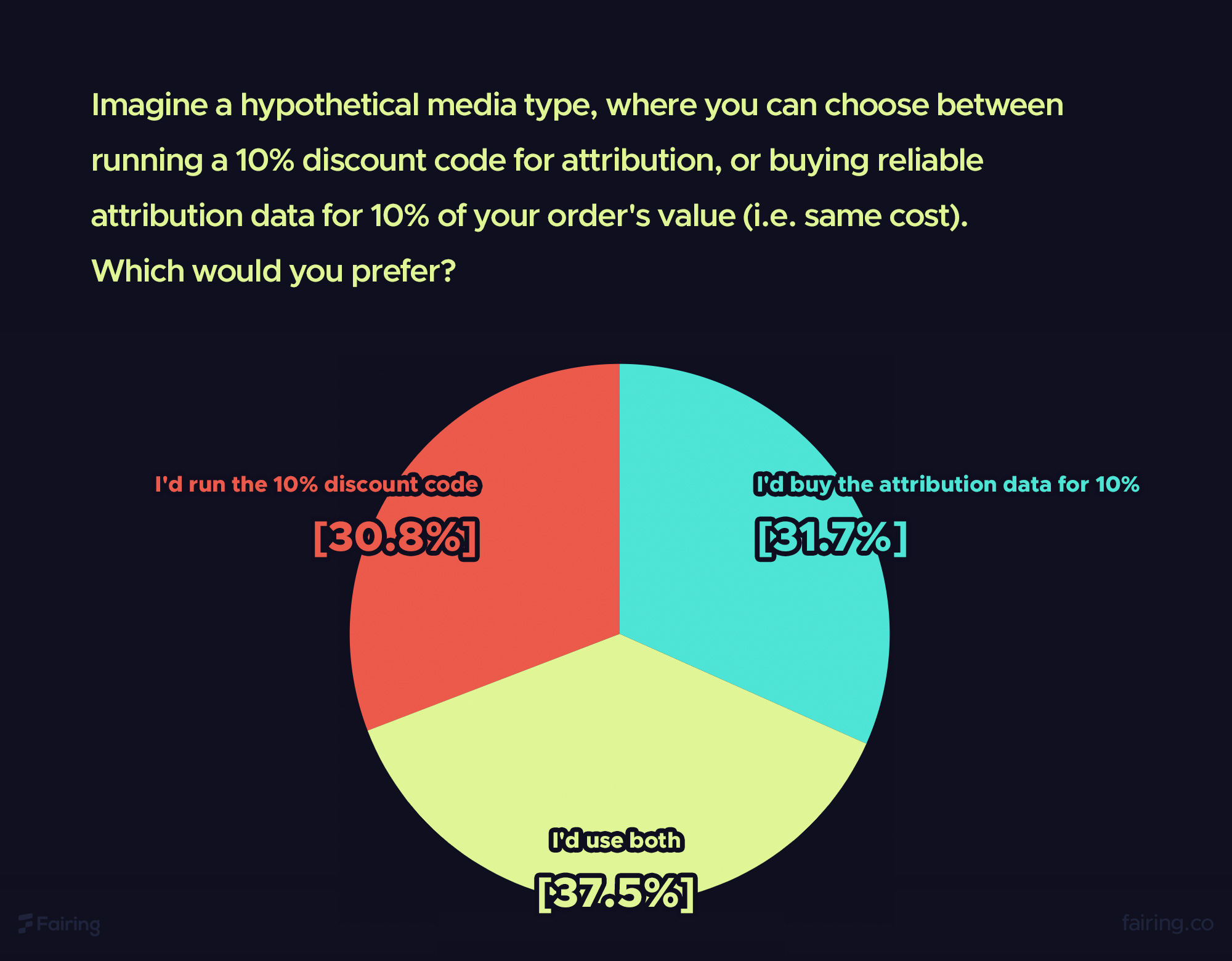Fairing’s Dark Attribution ROI Calculator
Fairing tends to unlock previously invisible opportunities for brands,
and believe it or not, there is a downside to that: you can’t really
measure the ROI of your Fairing
plan (at least, not without
coming to preposterous conclusions like “infinity percent”). Such is the
conundrum of going from 0-100; from an ROI standpoint, it’s far easier
to calculate 1-100.
However: one very quantifiable aspect about Fairing is that our
post-purchase surveys deliver a massive amount of attribution data to
your doorstep in real-time — much of it being the initial data point on
an otherwise dark conversion, which of course allows all your modeling
and budgeting to function as intended. This shift in your attributable
media mix happens the moment you launch Fairing, which is why we say
ROI from Day 1 .
So, if you ignore everything else Fairing does, you can at least say
something like, “Fairing gave me the data to solve a huge chunk of my
dark attribution problem.” And the dollar value of that dark attribution
data is…
Wait, how’d we get there? How much is an attribution data point worth
again? It turns out, no marketer has really asked themselves this
question. To most, attribution feels like air: you either have it (in
which case it seems worthless), or you don’t (in which case it seems
priceless).
Marketers typically just operate under an
assumption
that there’s the attribution you have, and then there’s the 20, 30, 40%
of conversions coming in with dark attribution which are a lost cause.
The problem with that assumption is 1) it’s mostly wrong, and 2) if it’s
wrong, then there’s some conventional marketing behavior that needs to
be rethought.
Finding Your DAVE (Dark Attribution Value Estimate)
Obviously the dollar value of a dark attribution data point is non-zero,
but with virtually no precedent as to what any attribution data point is
actually worth, we had to do our own market research by proposing some
hypothetical willingness to pay scenarios.
We surveyed 120 marketers in and outside our network, conservatively
responsible for $200MM in annual ad spend, and the key number they
identified is what we’ll call DAVE (Dark Attribution Value Estimate).
Effectively, it’s the estimated market value of a single dark
attribution data point, if you had the ability to simply buy it off a
shelf.
So, what’s the magic number? What is DAVE? It’s 10% of your Customer
Acquisition Cost . If your typical CAC is $20 and you’re staring at an
unattributed sale that just came in, you’d pay $2.00 to acquire a
reliable attribution data point on that sale.

Worth noting, this is the most conservative (i.e. unfavorable to
Fairing) figure we could report. It’s the weighted average of responses,
assuming the bottom of the range is what each respondent intended — for
instance, if you chose “<$0.50”, we recorded that value as $0.00
rather than assuming the range’s median value of $0.25. In other words,
we used a willingness to pay question format, but tempered it by
recording the lowest amount in that range.
We also rounded down the actual net result ($2.44 in this case) pretty
significantly. We did this in part to be as conservative as possible,
given the number is an estimate after all… and in part because it’s not
so easy to remember “DAVE is 12.2% of CAC.”
In our Dark Attribution ROI Calculator you previously saw, the math
happening there is quite simple thanks to DAVE. You give us an idea of
your unattributed sales volume, which lets us know how many dark
attribution data points per day you can expect to get from Fairing (our
typical response rate is ~50%, ergo you can expect half your dark
attribution to be lit up). We then multiply that by DAVE (10% of your
CAC), and extrapolate it to 30 days for an ROI comparison against your
monthly Fairing plan cost. So there’s your Fairing plan ROI, assuming
our platform had no other value to deliver.
Comparing Dark Attribution Value To Additional Data Points
Of course, you do indeed see additional value from Fairing — for
example, the pile of attribution data that offers second opinions on
your already (pixel) attributed conversions, and keeps ad platforms from
grading their own homework. But how much is an additional attribution
data point worth?

Using DAVE as an anchor, our study concluded that additional
attribution data points hold roughly 20% of an initial data point’s
value: 2% of CAC . In keeping with the aforementioned example, it
would translate to paying $0.40 for a second attribution opinion on your
$20 acquired customer cost.
We could have included these secondary attribution data points as
contributing additional value to your Fairing Plan ROI calculation, but
it would’ve made for a less intuitive experience… and again, the
calculator’s claim to fame is that it isn’t even considering any other
value delivered by Fairing. Lighting up dark attribution alone is enough
to offset our plan cost.
Frame Of Reference: Discount Codes
No matter how many marketers one surveys on this topic, the conclusions
will still be anchored in theory rather than practice — because again,
most marketers simply accept the attribution they’re given. Or do they?
Some of the hardest media to measure rely heavily on discount codes as
their attribution safety net. And while these codes produce other
impacts (some good, like increasing conversion rate… some not so good,
like decreasing perceived value), they are in large part employed for
the purpose of lighting up dark attribution. Said another way: brands
buy attribution data all the time, via discount codes.
Knowing that a 10% discount is a pretty typical and modest deal, we now
had a very real anchor for practical market value on DAVE. As such, we
asked our survey respondents a rather bold question: if you could just
buy the dark attribution data point itself for the same cost, rather
than run the discount… which would you prefer?

To acquire a dark attribution data point, 69% of marketers would
prefer to buy it for 10% of their order’s value instead of (or in
addition to) running a 10% discount code . Understandably, there will
always be some dissenting marketers who feel discount codes offer a
worthwhile net benefit beyond attribution; we’re not here to rid the
world of discounts. But the fact that a strong majority noted a
willingness to pay 10% or more of their order value — not CAC, order
value — makes an undeniable real-world argument that our DAVE figure is
indeed conservative. This is further validated by the practices of our
agency partners, who habitually require Fairing to be installed on a
brand’s site before running experimental campaigns or hard-to-measure
media
, wherein discount codes are often the de facto attribution solution.
That said, discount codes are often used as temporary measures for
gathering attribution, so we still think it’s best to stay conservative
with our estimates.
Want To Know More?
While we were pleased to see the business case for Fairing prove itself
as an ROI no-brainer, dark attribution is ultimately just one of many
needs our zero party data platform addresses for DTC brands. Some of
those use cases are incredibly compelling, and ones we truly enjoy
revealing to our customers — so, with the financial justification now
out of the way, we’d love to showcase the rest of Fairing’s value for
your team. Schedule a personal demo today ,
or get started for free and let our Customer
Success team show you ROI from Day 1.